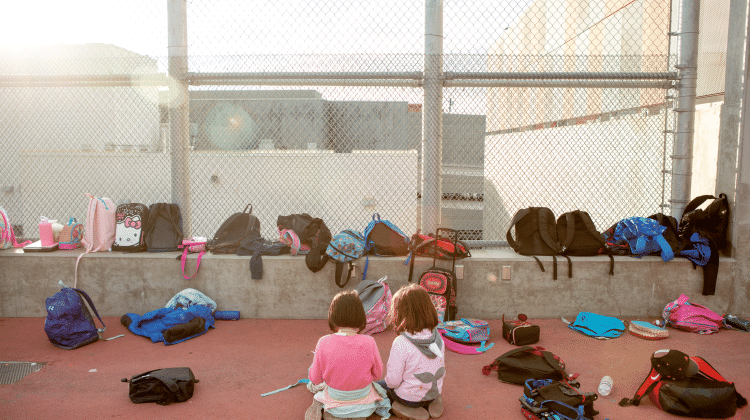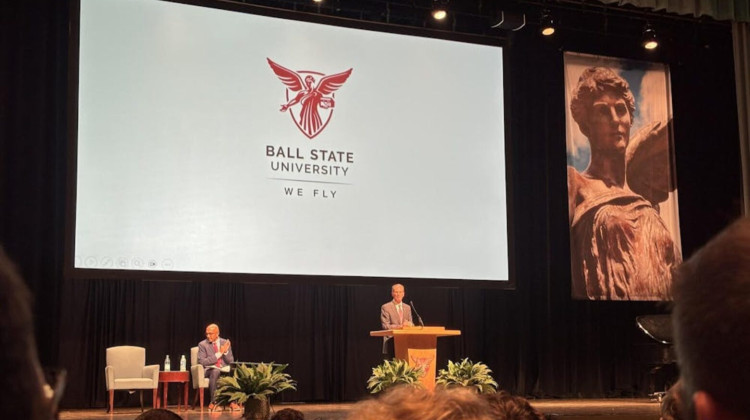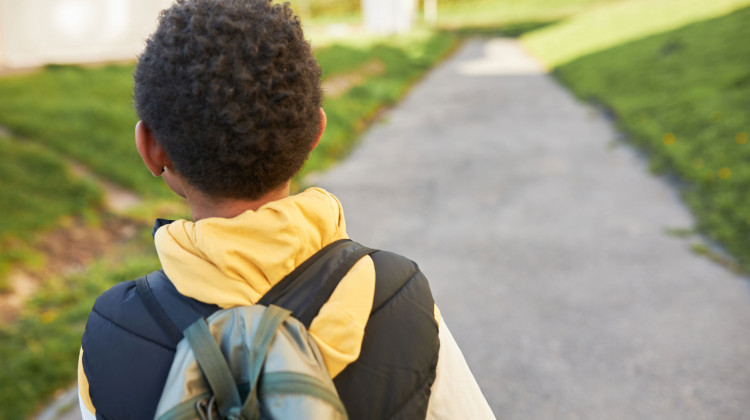
Eighth graders Nathan Howell and Michael Salle-Beeler said George Washington Community High School has a bad reputation for a good reason.
Hayleigh Colombo/ChalkbeatA new principal is trying to turn around one of IPS's most troubled high schools
Adela Campos decided to skip her senior year at George Washington High School to get away from the violence.
There’s just nothing left for her at the West side school, she said. Her friends, many who are also Hispanic, have transferred to other schools. Her schedule was dotted with substitute teachers.
But above all, the 18-year-old from El Salvador said she doesn’t feel safe. So she pushed herself to graduate early.
“The students basically took over the school,” Campos said. “There’s fights almost every day. You don’t know if somebody is going to come up and hit you for no reason.”
The urge to flee has spread among Hispanics at a school that has long been a hub for them. Last year, nearly a third of the students — 32 percent — were Hispanic. This year, that percentage dropped nine points to 23 percent.
For the first time in five years, George Washington — located in the center of one of Indianapolis’ most heavily Hispanic neighborhoods — no longer has the district’s largest share of Hispanic students.
Students, staff and community groups in and around the school are demanding change, arguing George Washington has spun out of control this year.
“The Latino students are feeling very much oppressed,” said Monica Medina, an IUPUI professor who works in George Washington training future teachers. “We’ve created a school that in many ways represents a prison … similar to a criminal experience because of the punitive environment.”
But Superintendent Lewis Ferebee and other district officials don’t believe the situation is as bad as some say.
“Has there been fights? Probably so,” Ferebee said. “It happens at every high school. We’ve got a first-year principal and she’s building her network. It remains on our radar as one of the schools that is under state intervention and we have high expectations for student achievement.”
‘The school where everybody fights’
The hallways of George Washington High School were empty and quiet after school had let out on a recent Wednesday as eighth graders Nathan Howell, 14, and Michael Salle-Beeler, 13, horsed around in the cafeteria, tossing around a quarter they found.
But earlier that day, the boys said a student set off a fire extinguisher, spraying flame-retardant foam everywhere. The calmness of after school was the exception; the chaos of the foam sprayed around the hallway was more common, they said.
Students there fight over just about anything, they said.
“I heard a bunch of kids say ‘That’s a school where everybody fights,’” Salle-Beeler said. “It’s really true.”
The problems have occasionally bubbled up into the news since the start of school. In August, a large fight interrupted a morning biology class. In October, parents protested outside the school after a student’s nose was broken in what some said was a racially charged fight. In March, the parents of a George Washington student who was brutally assaulted in a park by another teen said the school hadn’t properly handled her claims that she was bullied.
Emily Butler, the school’s first-year principal, held a parent meeting after the protest and last month the school hosted a Cinco de Mayo party to celebrate Hispanic culture.
“We want to welcome all students and families here at Washington and make sure all students feel safe,” she said.
But Medina said those gestures haven’t worked.
“It’s like putting a little band-aid on a huge sore,” she said. “That whole idea of creating an environment that’s inclusive never really happened.”
Campos said many of her Latino friends have since transferred. Many have gone to Arsenal Tech High School, she said, because they believe there’s more opportunities there.
Campos is graduating early and heading to Ivy Tech Community College next year.
“A lot of my friends have left,” said Campos. “I tried to leave but my mom didn’t let me. We’re a minority.”
Jesse Pratt, the school’s academic improvement officer, said he didn’t believe the school was hemorrhaging Hispanic students.
“I’m not seeing a mass exodus of Hispanic students,” Pratt said.
The school has 258 Hispanic students, based on a count in mid-May provided by IPS. Last year, the school had 321 Hispanic students, according to the Indiana Department of Education. That means one in five Hispanic students appears to have left in a single year.
This is also the first time in five years George Washington’s Hispanic enrollment has fallen below 30 percent — which was by far the highest percentage of any IPS high school. But George Washington now ranks only third in the district for the percentage of Hispanic students. Instead, Arsenal Tech and Northwest high schools have become the biggest centers for Hispanic students in the district, tied at 26 percent of enrollment.
Mixing students from different neighborhoods— more prevalent at George Washington the last few years — has been a big factor in the enrollment change and in rising tension, said IPS school board president Diane Arnold. A flood of IPS students left Arlington, Howe and Manual high schools — a lot of them went to George Washington — when the state took them over in 2012, she said.
“Now we have kids that live in Arlington High School’s neighborhood getting bused into Washington,” Arnold said.
But Medina said a bigger problem is that the school hasn’t been supportive of its many minority populations.
“Now we’re putting blame on people who are not from our neighborhood,” Medina said. “I’m not convinced that the environment that has been created at that school is one that is welcoming to almost any of those groups.”
‘Fallen significantly short of the goal’
It wasn’t supposed to be this way at George Washington.
The school had strong neighborhood support from groups that pushed to reopen the school in 2000, five years after it closed down because of low enrollment. Advocates hoped the school would be reborn an anchor for the city’s West side, and over the years have provided health resources, social services and other programs for the students.
Groups including the Indianapolis NAACP, Concerned Clergy of Indianapolis, Indiana University School of Education, IUPUI and Mary Rigg Neighborhood Center say they have called on IPS administrators to help fix what they see as increasing problems at George Washington.
They want to see an action plan for improvement next year.
“When we believe the school community has fallen significantly short of the goal, we naturally take notice and demand collective attention be directed to rectify shortcomings,” according to a joint statement from those groups. “Unfortunately for many of us, this is such a time.”
It’s not just ethnic minorities that need more support. The district acknowledges, for example, that staff shortages probably means special education students were not always correctly served this year, possibly in violation of federal law.
High turnover with the school’s leadership and its teachers has been an issue. George Washington is on its third principal in three years.
Joscelyn Mathis, a special education assistant at the school, said she was frequently pulled away from her job in order to substitute teach in other classrooms. But students with federally required Individualized Education Plans need to be taught by specialists who can assure they stay on track, she said.
“I believe that several teachers brought it to their attention that IEPs weren’t able to be followed, not because we didn’t want to follow them but because we didn’t have the means to,” Mathis said.
Pratt acknowledged the teachers were improperly pulled away from special education students, but said the practice has since been ended.
“The concern was (about) using special education (teachers) to cover classes while the regular teacher was out,” Pratt said. “(Butler) was doing that until she found out that was incorrect. She changed that philosophy.”
A new effort to bring stability
George Washington will have at least a measure of consistency next year when Butler, a former Teach for America teacher who previously held leadership positions in Baltimore schools, returns.
Every class period without disruption is a success to Butler. It’s the small gains that will add up to big changes, she said.
Last Thursday morning at the school, Butler was admiring four quiet hallways on a camera monitor in her office. There were no roaming students visible. That progress has been a year in the making, she said.
Sending kids back to class and reducing the number of suspensions were her biggest accomplishments this year, Butler said. Last year there were 1,300 suspensions at the school. This year there were about 1,100.
“We didn’t magically correct the problems in my first few weeks,” Butler said. “I’m frankly getting tired of hearing how my building is out of control. I can’t say it was like that in the first nine weeks of school. A turnaround process doesn’t happen overnight.”
She also created a special program for struggling, older middle schoolers, most of whom have been held back at least one grade, called Accelerate Academy. They’re now in a different wing from other students, on a separate schedule and have teachers permanently assigned to the program. The goal is to try to help the students catch up academically and reduce misbehavior.
“You have a 15-year-old seventh grader sitting in with 12-year-olds,” Butler said. “These kids were really exhibiting extreme behaviors. Just putting them with their equally aged peers has really helped a lot. Just getting that program started was a herculean effort.”
The next step, Butler said, is bringing stability to the staff.
The problem this year was that Butler was hired too late to adequately fill all the teaching openings at the school, Pratt said. Some students reported having substitute teachers in core classes like biology for entire semesters.
IPS parent Delana Ivey, whose eighth-grade sons started the school year at George Washington after being placed on the waiting list for a magnet school, said she was upset by how often they were taught by substitute teachers.
“When students are being told they’re going to a place that isn’t even prepared for them, I’m offended,” said Ivey, who is a member of the advocacy group Parent Power Indianapolis. “How is it possible to even learn when you don’t have a teacher?”
Still, Pratt argued that more stability in leadership and the teaching staff next year should help.
Butler also has higher expectations for discipline, he said. Next year, teachers will be trained to better deal with unruly students. Ferebee said Butler has his full support.
“There’s a new chief in town, and with a new chief there’s different expectations,” Pratt said.
For example, Butler said she doesn’t want to automatically discipline a roaming student. Instead, she wants to know why they’re not in class.
“Some of my kids walking the hallways, they’re bored,” she said. “They’re not being pushed. Instruction may not be as engaging or age-appropriate as it needs to be.”
Pratt said the idea is to focus on the big problems, not small infractions.
“She’s not going to put a kid out of class because they have on the wrong color socks,” Pratt said. “We’re more concerned about whether that kid can read and write.”
But if Butler has a tougher approach to discipline, Campos said that wasn’t apparent to students. If anything, some rules seemed more relaxed, she said.
“The years before, they enforced the dress code policy,” Campos said. “Most of the time (now) they don’t say anything to you. You could walk in there with pajamas. What’s the point of having a dress code policy if they’re not going to actually enforce it?”
IPS leaders disagree about how to handle issues
To Arnold, another principal change this year may have prompted more complaints.
“There may be some people there that aren’t happy,” Arnold said. “Change is difficult for people. I hear the same stories, that people are running amok. I don’t see that when I go in there.”
But Gayle Cosby, a board member who is often at odds with Arnold and others, said IPS’s response has fallen short. Cosby said she consistently hears complaints from the school that worry her.
“It’s not prudent for IPS to continue to stick their head in the sand and try to ignore problems that are occurring on a daily basis,” Cosby said. “When we hear concerns, we need to be as proactive as we can in addressing them.”
For now, some kids are trying to stay away from the fighting.
Salle-Beeler and Howell, who both transferred to George Washington High School after getting in trouble at Broad Ripple High School, each made new year’s resolutions not to get suspended.
But it can be a daily challenge.
In fact, they were trying right then during their after-school program to resist retaliating against a classmate who had sprayed Howell in the face with apple juice.
Salle-Beeler said getting a high school diploma is what motivates him to stay out of trouble.
“I don’t want to take the chance of getting expelled,” Salle-Beeler said. “I need to get my education and get out of this place.”
Chalkbeat Indiana is a nonprofit news site covering educational change in public schools.
 DONATE
DONATE






 Support WFYI. We can't do it without you.
Support WFYI. We can't do it without you.